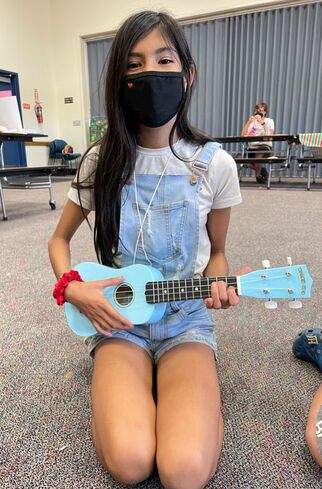 A Summer Strummer at Euclid Elementary A Summer Strummer at Euclid Elementary 30,000 students from all over the San Diego Unified School District took a journey into in-person learning this summer as participants in the district’s new program, Level Up San Diego, funded by federal ESSER support for pandemic recovery. Students could enroll in a.m. summer school focused on learning recovery, and in a variety of summer enrichment opportunities such as outdoor activities, Arts classes, or STEAM-related programs, offered by 65 organizations. Many students participated in both morning and afternoon activities intended to restore joy and inspire a passion for returning to learning. Guitars and Ukes in the Classroom (GITC) was honored and excited to be among the first organizations included in this opportunity, made possible because of grant support from The San Diego Foundation. Thanks to the local partnership, we were able to provide music instruction integrated with arts and crafts and literacy enrichment on seven SDUSD summer school campuses, as well as online for students ages 3 through 18. We called our programs Summer Strummers Clubs so students felt a sense of belonging to something special… and parents are reporting that they really did! To fully staff GITC’s Level Up SD: A Summer of Learning and Joy, we expanded our faculty, bringing on amazing, highly qualified public school teachers and specialists from Vista, San Diego and Chula Vista as our Club Leaders, and interns in support positions in education and music programs from SDUSD, Cal State San Marcos, Point Loma Nazarene University, and Grossmont College! It “took a village,” to staff our clubs, and that village extended to the boundaries of San Diego County! 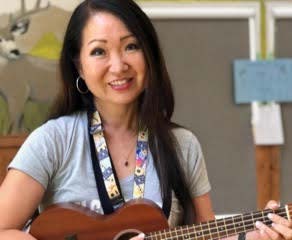 GITC Instructor Mimi Seney GITC Instructor Mimi Seney But one Summer Strummers Club Leader wanted her young club members to experience even more of the world. Mimi Seney, the Monday afternoon Club Leader at Euclid Elementary, took her students on a musical journey around the world! Assisted by her intern, Mr. Gilbert, himself a middle school math teacher at Logan Memorial Educational Campus (LMEC), Mrs. Seney brought the world into her classroom through the power of international music and crafts. Club members travelled to the UK, Italy, Greece, South Africa, Japan, Hawaii and more, learning about each country’s culture, flag, and music -- all within the span of four weeks! 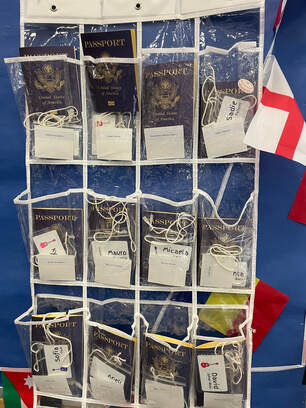 Student passports -- Let's go! Student passports -- Let's go! “Each student received their own passport, which got stamped along the way,” explains Mrs. Seney, who has been active with GITC for about seven years. “At each stop, the kids colored pages with facts about the country or flag, which were made into a travel journal to take home. And each week, we talked about the music that comes from each culture and learned a new song on ukulele.” Mrs. Seney also helped each student create a “Strumming Flat Stanley” - a paper cutout inspired by the Jeff Brown children’s book series Flat Stanley's Worldwide Adventures Students were encouraged to take photos of their Strumming Flat Stanley at various locations around town or on family outings and share them with the group. “The kids love to see Stanley out and about, even if he’s just at Starbucks,” she explains. 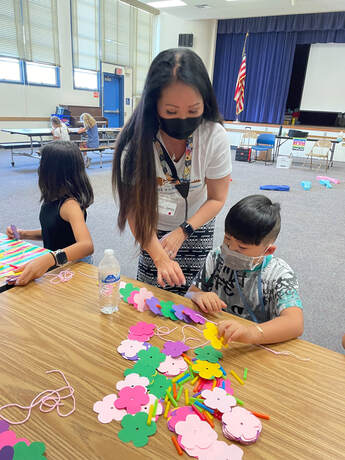 Mrs. Seney helps a student assemble a lei Mrs. Seney helps a student assemble a lei This is Mrs. Seney’s first year joining GITC as a faculty member, but she began learning to lead and integrate music the GITC way as a teacher for Deaf and Hard of Hearing students at San Diego County’s Davila Day School. “I started by taking courses with GITC instructor Dan Decker and quickly got into it,” she explains. “I was a pianist and guitar player, not a uke player. At the time, most of my preschool students were non-verbal or just acquiring language. GITC’s approach was a great fit for that and I was immediately hooked. After teaching preschool, I decided to move into working with an older, more diverse group of students at a youth detention center. These days I teach math and science and integrate music, including after-school ukulele and keyboard classes at the East Mesa Juvenile Detention Facility, and I just love it!” Mrs. Seney has also enjoyed her role as a Summer Strummers Club Leader. “It was something so different and healing for all of us.”
0 Comments
GITC loved participating in Level Up SD: A Summer of Learning & Joy! Thank you to all the students, instructors, volunteers and families who joined us for this unique summer experience. We played music, made art, and found joy again after a very challenging year. This program was made possible thanks to support from The San Diego Foundation. Please enJOY our Summer Strummers 2021 Photo Gallery: Clay ElementaryM/W Club Leader: Maria Weiss Intern: Suzanne Chin T/Th Club Leader: Mark Spencer Intern: Rachael Holmes Dewey Elementary T/Th Club Leader: Katie Stoesz E B ScrippsT/Th 12:30pm Club Leader: Garner Saguil Intern: Nohemia Rosales T/Th 3:00pm Club Leader: Garner Saguil Intern: Autumn Harris Euclid Elementary T/Th Club Leader: Reagan Duncan Intern: Aliyah Holmen Euclid Elementary M/W Club Leader: Mimi Seney Intern: Rhico Gilbert Foster Elementary : T/Th Age 6-7 Club Leader: Teresa Adams Intern: Jonathan Hanninen T/Th Age 8-10 Club Leader: Elisa Samaniego Intern: Madeline Samaniego LMEC M/W Club Leader: Connie Gonzales Intern: Lara Wuhrmann T/Th Age 3-5 Club Leader: Connie Gonzales Intern: Jean Borja T/Th Age 6 - 8 Club Leader: Maria Weiss Intern: Jorge Flores Nye Elementary: M/W Club Leader: Gingerlily Lowe Intern: Teresa Adams T/Th Club Leader: Gingerlily Lowe Intern: Erin Leavitt GITC is thrilled to be participating in Level Up SD: A Summer of Learning and Joy! We'll be providing musical after-school programming at multiple Level Up SD sites, and we couldn't do it without the teaching artists listed on this page. Please take a moment to get to know these GITC superstars who are helping kids Level Up this summer! This program was made possible thanks to grant support from The San Diego Foundation. Meet Our Team! Name: Teresa Adams Level Up Location: Foster Elementary School During the Year: Dailard Elementary Grades You Teach: I am a Paraeducator Independence Learning Facilitator, currently working with mild moderate second graders Years with GITC: 3 Favorite Activity: I enjoy hiking, camping and taking pictures of my sister’s garden. Fun Fact: I was a Teenage Mutant Ninja Turtle.  Name: James Clarkston Level Up Location: Online School During the Year: LA USD Grades You Teach: 6-12 Years with GITC: 6 Favorite Activity: Running Favorite Summer Food: Tacos Fun Fact: I once performed classical guitar music at a party for former President & Mrs. Bush.  Name: Reagan Duncan Level Up Location: Euclid Elementary School During the Year: Maryland Elementary (Vista, CA) Grades You Teach: Kinder & 1st Years with GITC: 1 Favorite Activity: Hiking & visiting the beach (w/ a uke, of course!) Favorite Summer Food: Watermelon Fun Fact: My parents were in the circus when they met!  Name: Connie Gonzales Level Up Location: LMEC Logan Memorial Educational Campus School During the Year: LMEC Logan Memorial Educational Campus Grades You Teach: Montessori - Pre-school, TK & Kinder Years with GITC: 10 Favorite Activity: Dancing, gardening, family barbecues, outdoor water activities, touring wineries, and riding nice n slow on a big ol' Harley Davidson motorcycle! Fun Fact: I am a San Diego native, born and raised, and have four adult children and five grandchildren! I am a Flamenco dancer and a member/actor in a community theatre group.  Name: Gingerlily Lowe Level Up Location: Nye Elementary School During the Year: Recently retired from Nye Elementary Grades You Teach: Over my 33 years of teaching, I have taught from 1st grade all the way up to 8th grade. Years with GITC: 4 Favorite Activity: Dancing in the Japanese Obon Festival-- a community circle dance festival celebrating our dear departed. Fun Fact: I grew up in Chinatown. When I was a little kid, the Art Linkletter House Party had a segment "Kids Say the Darndest Things". They wanted a "Chinese" kid on the program and came to my school to find one. I was lucky to be selected. And that's how I got my first bicycle--a blue Schwinn which was my prize for doing the show.  Name: Garner Saguil Level Up Location: EB Scripps School During the Year: Dingeman Elementary Grades You Teach: 4th Grade Seminar and Choir Director Years with GITC: 2 Favorite Activity: I love to run, cook, and travel to tropical climates. Fun Fact: I just adopted a husky and golden retriever puppy from a shelter in Ensenada, Mexico. I named him Baja, and he's currently the love of my life.  Name: Elise Samaniego Level Up Location: Foster Elementary School During the Year: Foster Elementary Grades You Teach: 4th Years with GITC: 3 Favorite Activity: I go to Idaho every summer with my family - fresh air, river rafting, and relaxing with no TV, computers, phone or internet. Fun Fact: I was a concert violinist for 12 years!  Name: Mimi Seney, Ed.M Level Up Location: Euclid Elementary School During the Year: East Mesa Juvenile Detention Facility Grades You Teach: High School but have taught pre-school through 12th, adult learners and special education (DHH) Years with GITC: 6 Favorite Activity: Pool time and ukuleles! Fun Fact: I have two mini schnauzers (Charlotte & Savannah) and love quilting in my spare time! 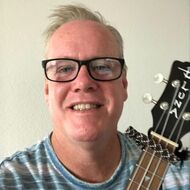 Name: Mark Spencer Level Up Location: Clay Elementary School During the Year: Veterans Elementary Grades You Teach: 3rd Years with GITC: 3 Favorite Food: Sushi Fun Fact: Besides being a teacher, I have 3 wonderful children with my wife Krista (also a teacher), I am an Uber driver on weekends, and I enjoy acting in community theatre. 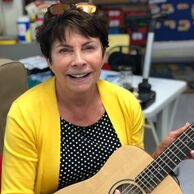 Name: Patti Steele Level Up Location: Floater/Substitute School During the Year: Recently retried from Paradise Hills Elementary Grades You Teach: Tk & Kinder Years with GITC: 3 Favorite Summer Food: Cherries Favorite Activity: Reading at the beach Fun Fact: I take tap dancing lessons! 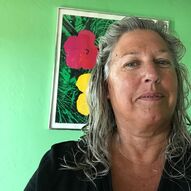 Name: Katie Stoesz Level Up Location: Dewey Elementary School During the Year: Dewey Elementary Grades You Teach: 2nd Years with GITC: 6 Favorite Activity: I enjoy the beach and the pool. I read a lot. I enjoy watching people play live music! Fun Fact: I swim a mile in a pool 4 days a week. 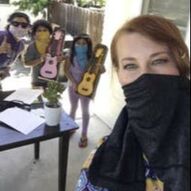 Name: Maria Weiss Level Up Location: Clay & Foster Elementary School During the Year: Doyle Elementary Grades You Teach: 5th Years with GITC: 2 Favorite Activity: The end of my gym class always makes me very happy! Fun Fact: I played college volleyball at the University of San Diego Additional Staff Profiles Coming Soon! 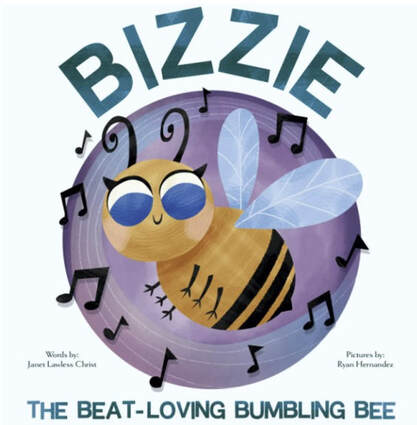 This month at GITC, we are buzzing...about bees! Bees fly from flower to flower, spreading pollen wherever they go. They are vital to the pollination cycle and help plants grow and thrive. They live in hives, or colonies, and work together to create something sweet -- honey, of course! GITC is a lot like a hive. Our entire community works together to create something sweet -- access to musical learning for ALL students! And just like bees fly from flower to flower spreading pollen, GITC teachers “fly” from student to student, spreading creativity and an enthusiasm for learning. 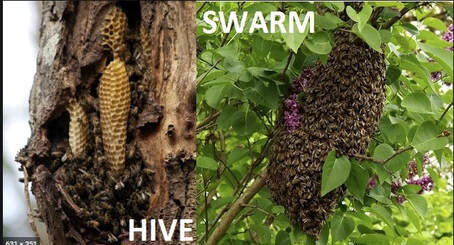 This year, due to COVID-19, we re-homed our own hive from in-person school to online classrooms! Sometimes bees must be rehomed in nature, too, in order to be safe and keep humans safe, too. Rancho Santa Fe author, Janet Lawless Christ, puts a musical twist on the topic of bee rehoming in her new book, Bizzie the Beat Loving, Bumbling Bee. In this picture book for children ages 2 through 9, two humans use the power of music to re-home a swarm of “bumbling” bees. And although this strategy is different than how professional bee rescuers re-home bees, we love Janet’s positive message and creativity! We are also buzzing with excitement to announce that Janet’s company, JoyWorks Networks, Inc, is donating a portion of the proceeds from Bizzie to GITC! “Teaching children about complementary relationships between different species, and how we humans can adapt our ways to support others to thrive is such important, compassionate work,” explains GITC's Executive Director, Jess Baron. “Students and teachers everywhere are going through an unimaginable this year. It is our hope that Bizzie will inspire young students to overcome their fears to find gentle and caring solutions that protect creatures great or small like the bumble bees." 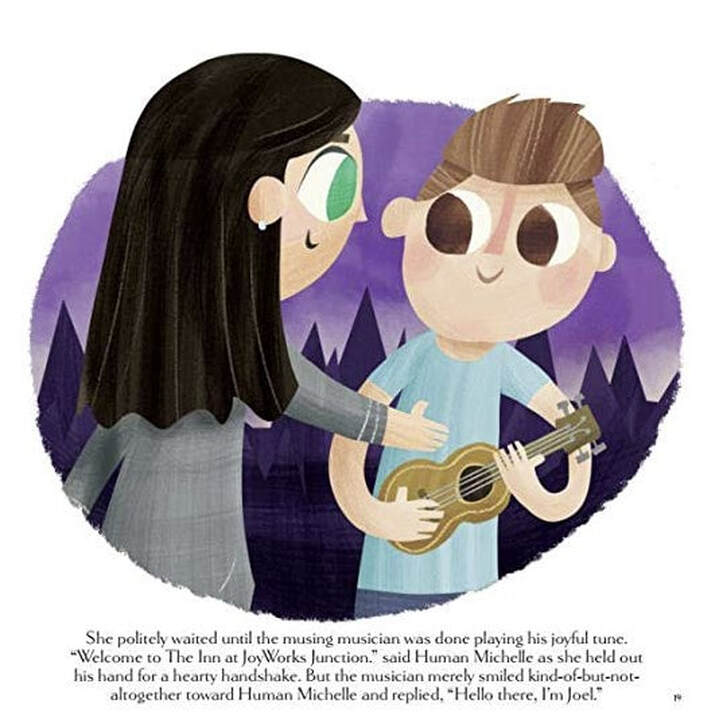 Ms. Christ's journey learning to play the ukulele also plays a key part in her story. She feels passionately about music and its importance in the lives of all children. So she chose our nonprofit as a beneficiary to receive a portion of the book's profits. We are most grateful for her support. You can read more about Janet Lawless Christ and Bizzie HERE! Learn about Ms. Christ's organization, Joyworks here: joyworksnetworks.com/products/bizzie-the-beat-loving-bumbling-bee. Guitars and Ukes in the Classroom is committed to protecting and healing our planet and we celebrate and teach about ecology through our Green Songbook!
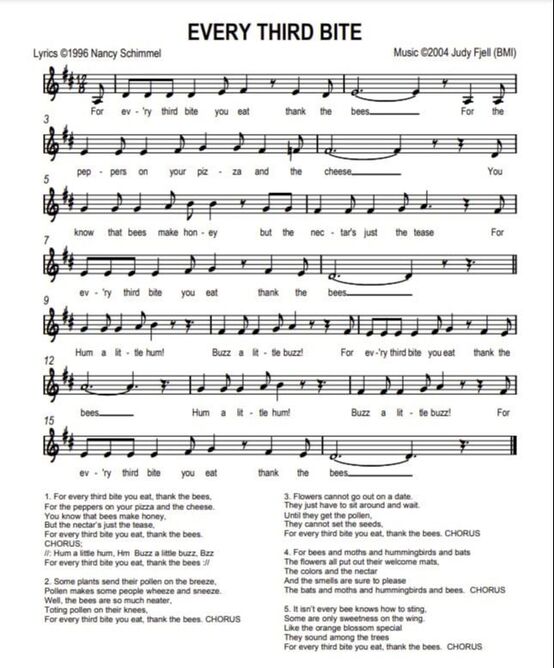 To explore safe methods for re-homing bees and to learn the latest progress addressing Colony Collapse Disorder please explore these resources below. Four Tips to Rescue a Honey Bee Swarm https://www.hobbyfarms.com/4-tips-to-rescue-a-honey-bee-swarm-2/ Re-Homing a Wild Hive video https://www.youtube.com/watch?v=usvWMIBuqKw Honeylove Be-Rehoming in Santa Monica https://honeylove.org/rescuebees/ San Diego Bee Re-Homing Expert https://honeybeerescue.com/ Colony Collapse Disroder Progress Report, 2020 https://www.hobbyfarms.com/colony-collapse-disorder-update-2020/ Also make sure to check out GITC volunteer, Rich Poser's incredible account of his personal experience moving a live colony and their beehive safely out of his roof! Download the full PowerPoint presentation or PDF below. The PowerPoint has a book animation feature when played as a slide show.
Changing the World Through Music: How One Teacher Is Shifting Her Entire School’s Culture with GITC1/14/2021 By Abby Dorsey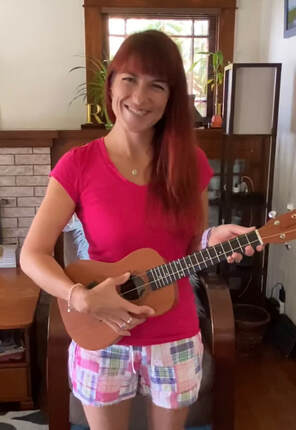 First grade teacher Reagan Duncan First grade teacher Reagan Duncan Maryland Elementary School first grade teacher, Reagan Duncan, closes each day of virtual learning with the same instructions for her students -- “Go out into the world, my little world changers!” she says cheerfully via Zoom. “I figure if they hear it every day, they will start to believe it.” Miss Duncan is the ideal person to talk to her students about changing the world, as she herself is currently shifting the culture of her entire public elementary school in Vista, California towards making music. After a chance meeting on a San Diego street corner with Guitars in the Classroom’s founder Jess Baron, Miss Duncan signed up to take her first ukulele class. She was immediately smitten. “I’d been looking for this thing -- something that would help me shift my students’ trajectory in life, ” she explains. “My school has the highest number of homeless students in the district. Many of my students are English language learners. My biggest hope is always to shift their trajectory with small, positive changes. Even if it’s just three degrees, it has the power to change their lives when they are adults.” 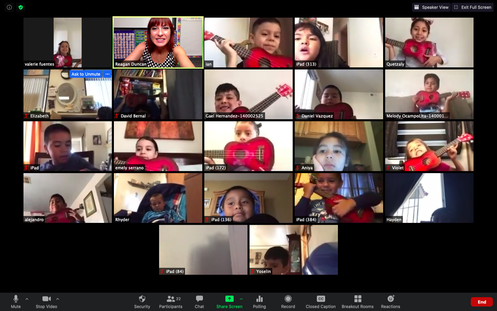 Miss Duncan and her first graders Miss Duncan and her first graders Uke Can Do It! Miss Duncan found the effects of the ukulele to be just that -- life changing. Just as she started her GITC training, the pandemic hit, and she was forced to make the transition to distance learning with a whole new set of challenges. How would she keep first graders engaged over Zoom? How could she convince six year olds to show up to class online when school attendance was already a challenge for them before COVID-19? The answer, it turns out, was right in her hands. “I started playing ukulele and singing songs with my students virtually last spring and immediately noticed that my language learners were picking up words faster with music,” she explains. “So when distance learning continued this fall, I decided that even though I was still teaching virtually, I was going to teach my kids to play the uke, and they couldn’t just watch -- they needed it in their hands!” Reagan put a call out on Facebook for friends to help her fund instruments for the students to play at home, and in about a week, she had enough donations to empower GITC to provide a ukulele for every child in her class with subsidized support from Kala Brand Music, one of Guitars in the Classroom’s enduring sponsors. 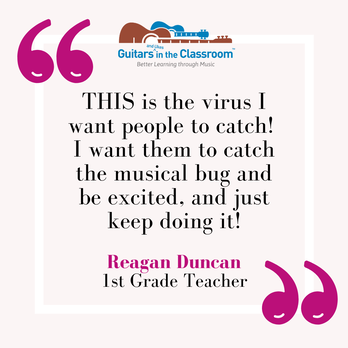 Now midway through the school year, every morning the students begin with fifteen minutes of songs accompanied on ukulele. “That’s how we start the day, and if they miss it, they’re disappointed! As a result, I have excellent attendance,” she laughs. “Both attendance and participation are higher because the music helps keep kids engaged. We pick our ukes up throughout our lessons each day to practice grammar, syntax, basic structure and punctuation. It translates so well into language arts and brings new vocabulary into their world through song. I never feel like I’m wasting my time as a teacher when I add music to my lessons.” Neither, it seems, do other educators at Miss Duncan’s school. Since starting her training with GITC, Reagan has inspired sixteen more Maryland Elementary staff members (including the school psychologist, school nurse, and both special education teachers) to enroll in the program. This January everyone is taking one of GITC’s Total Beginner or AMAISE for Beginners courses! 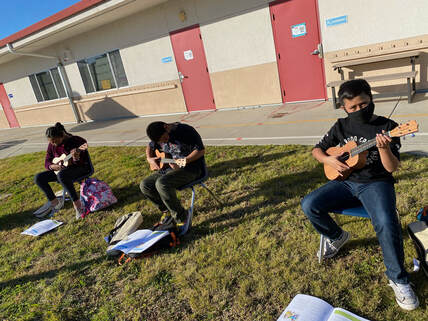 Socially distanced strummers Socially distanced strummers “Momentum is building,” she reports. “Both my principal and assistant principal are excited. Over half the teachers in the school have signed up so far, with at least one teacher in every grade level learning how to incorporate music into everyday learning. I shared this with Jess Baron and we have a goal of creating musical continuity for our students from Tk all the way up through fifth grade!” We’re pretty sure they’re going to get there. Spreading the Joy Of course, Miss Duncan isn’t stopping with just recruiting teachers from other classes; she’s also actively fundraising to start student ukulele clubs for each grade level. She hopes that the model her school is building will serve as a point of inspiration and reference for other schools in the district. She already raised donations to empower GITC to provide 14 beautiful concert sized Tanglewood Tiare ukes through GITC’s partnership with Korg’s Educational Division called SoundTree. These larger instruments are wonderful for the 4th and 5th graders who are starting a ukulele club in person, socially distanced, outside next week! “I found love and passion for playing the ukulele and teaching with it,” shares Reagan, “and now I’m helping to create a culture of music and learning through song with my colleagues and our Maryland Elementary students,” she explains. “It brings me so much joy to see the kids enjoying it, and when someone feels inspired, it’s contagious. THIS is the virus I want people to catch! I want them to catch the musical bug and be excited, and just keep doing it!” Support Miss Duncan's Ukulele Clubs HERE! 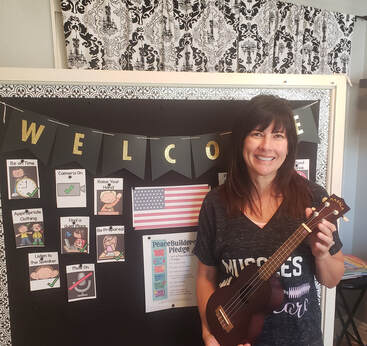 Jennifer Rittershofer AKA "Mrs. R" Jennifer Rittershofer AKA "Mrs. R" The first time Jennifer Rittershofer saw kindergarten teacher Julia Cole playing ukulele with her students, she knew she had discovered something special. At the time, Rittershofer (known as “Mrs. R” to her students) was working as a Reading Intervention Specialist for grades K through six in La Mesa, California. Part of her job included picking up students from their classrooms to take them to reading sessions, and she immediately noticed that something about Mrs. Cole’s class was different. “When I walked into Julia’s class, kids were engaged and singing. The energy was different and I wanted to stay,” Mrs. R explains. She decided to ask about the music and learned that Mrs. Cole had trained with Guitars in the Classroom (GITC), a national nonprofit that empowers teachers to use guitars and ukuleles to facilitate learning across all subjects. Her interest was piqued. “I thought maybe it could be a way for my students, many of whom were learning English as a second language, to be more engaged.” 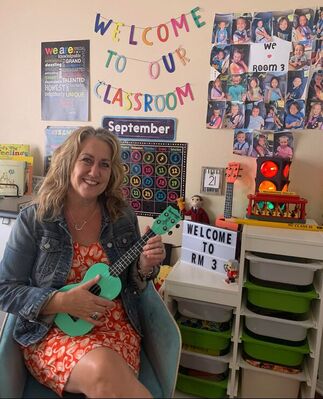 Kindergarten Teacher Julia Cole Kindergarten Teacher Julia Cole Lucky for Mrs. R, Mrs. Cole was not only a student of GITC -- she was also a Faculty Trainer who taught a weekly beginner class for teachers in their La Mesa school district. Mrs. R signed up and immediately took to the material. “Jenny caught on very quickly,” explains Mrs. Cole. “She would come pick the kids up with her uke and sing up and down the hall. I could tell she had a love and a knack for it.” In fact, Mrs. R had such a love for it that when the pandemic hit and the school year ended, she convinced her husband to take Mrs. Cole’s summer GITC class online with her. They strummed through the summer together, thinking the fall would bring a return to “normal” life. That return never came. Instead, Mrs. R learned that district funding for Reading Intervention had been cut and she would be returning to work in the fall as a third grade instructor teaching online. It didn’t take long for panic to set in. But then Mrs. R remembered one very important tool she now had in her toolkit -- her GITC training! Using her own funds, she purchased ukuleles and tuners for her entire class and quickly got to work. 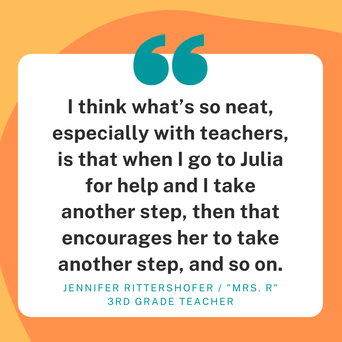 “No matter what the year looked like, I knew we needed to have something fun. It just needed to be different -- because this whole year has been different,” she explains. At first it looked like students might return to in-person class, so Mrs. R. held back on distributing the ukuleles. She played her ukulele during class time transitions and sang a morning song each day -- even on tough days when she struggled and made mistakes. “I really want them to know learning is hard. It’s a process, and adults make mistakes too,” she explains. “We were talking about empathy and I found the song Lean On Me to play for them. It was a challenge and I told them I was nervous to play it. It’s important that they know that things are hard for adults too. The truth is, no matter what I do, they are always excited and clapping.” Students were so excited by the music that a few who already had ukuleles at home began staying online after school hours to play and sing with their teacher. One student went as far as cutting a ukulele out of paper just so she could join the fun! But now that distance learning appears to be a more permanent arrangement, Mrs. R is preparing to distribute ukuleles to her students. She knows that they need the music now more than ever, as do their families. “When I had virtual back-to-school night, one of the dads saw my ukulele and he loved it. I think it’s something different and unexpected during this time when everyone is stressed about everything,” she explains. “I am definitely getting parents wandering over during class time and peeking in because it’s a different feeling than just playing background music. Even if I’m doing a bad job singing, it’s important for me to have a personal connection with the kids. It’s my way of saying ‘I know we’re not together, but I’m still here.’”  A "tuning party" to get student ukuleles ready for pickup A "tuning party" to get student ukuleles ready for pickup Mrs. R’s creativity and commitment to her students is also inspiring Mrs. Cole, the teacher who brought her to GITC in the first place. Mrs. Cole is now preparing to distribute ukuleles to her kindergarten students so they can strum and sing songs for learning at home. “She sparked a light in me,” Mrs. Cole explains. “She’s bringing GITC to her students and their families and it’s truly inspiring.” Mrs. R agrees that the bonds that form between GITC teachers are both strong and special. “I think what’s so neat, especially with teachers, is that when I go to Julia for help and I take another step, then that encourages her to take another step, and so on. And even though trying something new can feel scary, it’s worth the risk to feel a part of something [like GITC]. The reward is that we’re learning something and we’re sharing it together.” 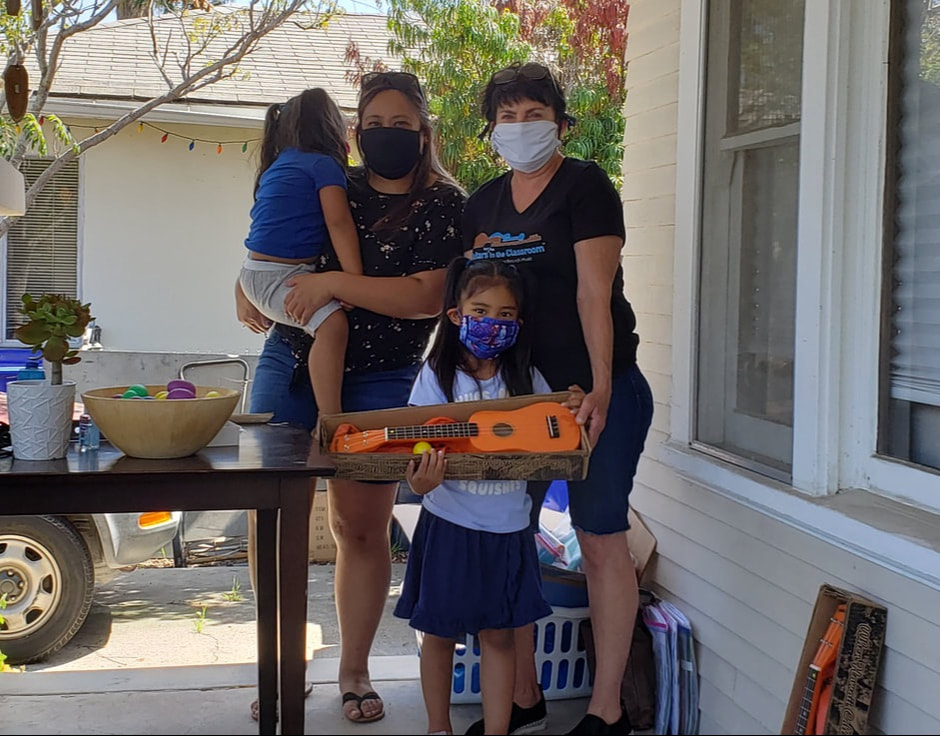 When T-K/kindergarten teacher, Patti Steele, organized a Guitars In The Classroom (GITC) Porch Pickup℠ to distribute ukuleles to her students learning at home back in March, she knew they would be excited. What she didn’t expect was how eager the students’ families would be to participate. She came to the home of GITC’s executive director to help hand the ukuleles out in person one weekend. 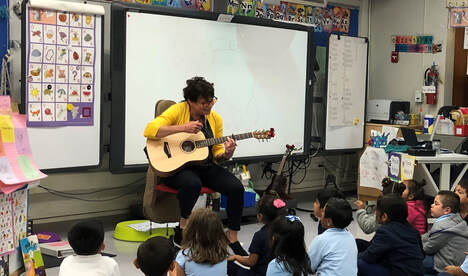 “I was actually shocked at how many families came out when the kids could pick up their instruments. They were all so excited,” explains Ms. Steele. “I got to see so many families, and by families I mean all the members, not just those I saw at drop-off or pick-up when school was in session.” Like many GITC teachers, Ms. Steele began the school year strumming and singing with her students in person as part of their everyday curriculum at Paradise Hills Elementary School in San Diego, California. But when the pandemic caused school closures, the class was forced to pivot online -- and if you can picture how difficult it is to keep a room full of kindergarteners engaged and learning in person, imagine the challenge of doing it over Zoom! Ms. Steele jokingly refers to her first weeks online as “a nightmare” but the technical challenges and the struggle to engage students through computers was anything but funny. Class attendance dropped and Ms. Steele feared she would lose track of some of her students. That is, until she reached for her ukulele!  “The greatest number of kids would show up when I said we were having ukulele time,” Ms. Steele explains. “And anytime our GITC teaching artist, Jefferson Jay, would join us online -- that’s when I had the most Zoom attendance.” These teaching artist visits to classrooms at Paradise Hills were co-funded by the San Diego Unified School District and District 4 Councilmember Monica Montgomery’s discretionary funding for her community through the City of San Diego. Ms. Steele was tapping into something that many GITC teachers are witnessing in online classrooms -- the power that music holds to engage students and increase focus and fun in distance learning settings. With all the boxes and buttons, Zoom sessions can feel impersonal or even uncomfortable for young learners. Add tech or language barriers and things get even more complicated. Music has the power to break through these barriers, or as Patti Steele puts it, to level the playing field. 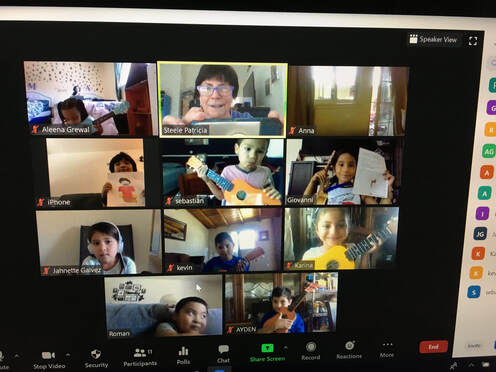 “Online learning is so hard at this age, but music is a way to reach them all and level the playing field,” she explains. “Some of the parents didn’t speak English, some had to go to work, but this was some common ground. I think the ukulele is what saved me, and the kids, too. It was a common denominator and it was the highlight of my Zoom classes.” 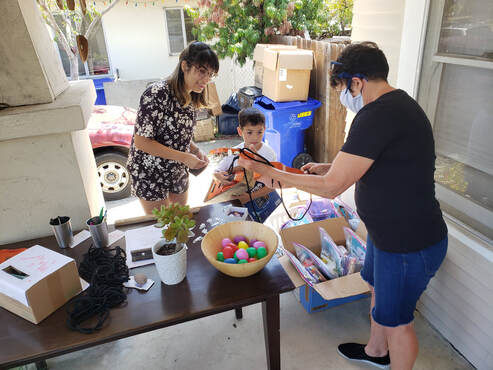 GITC set up a Play and Pay it Forward campaign online to raise funds for student instruments. Families who could afford to contribute did so, and some GITC benefactors helped out. This community approach made it possible for GITC to help many classes at the end of the last school year. Once her students had picked up their own instruments, Ms. Steele quickly noticed that they were not the only ones enjoying classroom ukulele time. Siblings, parents, grandparents, and pets began to join in the fun, too. When the class wrote a song about COVID to the tune of Wheels On the Bus, family members pitched in ideas. And at age 64, veteran teacher Ms. Steele felt like she was getting to know her students on a whole new level. “It was such a nice inside picture into their families,” she explains. “In one family, all the siblings had ukuleles and they would all sit lined up, on the couch with this huge cat, and play together. It was great. I learned so many things I didn’t know about them.” Ms. Steele is also using the pandemic as an opportunity to expand her own GITC training, with a current focus on guitar.  GITC Faculty Trainer Joan Maute GITC Faculty Trainer Joan Maute “Open [tuning] guitar is great for me and I’ve been doing that with GITC instructor, Joan Maute. I just love the sound of the guitar,” she explains. “Before that, I took a songwriting class taught by GITC founder, Jess Baron, and it was so moving to hear the amazing songs people wrote. I enjoyed getting to know everyone and the class really kept me going, despite the world feeling so scary. GITC classes have given me something to look forward to. They’ve also given me a window to the world while stuck at home, because the other teachers in my online classes are from all over the United States!” She may love strumming her guitar, but what is Ms. Steele most looking forward to when classes resume online in just a few weeks? Ukulele time with her students, of course! “I can use the ukulele in every subject and that’s the thing that’s great about it,” she explains. “It’s the thing I’m most excited about. It’s my highlight. And even if I retire, I still plan to volunteer with the teachers at my school to keep GITC going. I will help the young teachers coming in and say, “I’ll sit with you in class. I’ll tune your ukes. I’m just here to help you.’ I want to do something to take away the obstacles they think are in their way. So many avenues open up through music that we don’t even know about. It levels the playing field and brings people together -- especially now, when there is so much divide.” Check out these great photos of Patti Steele's class: 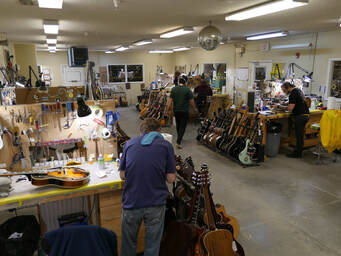 MIRC headquarters in Franklin, TN MIRC headquarters in Franklin, TN Please join us in welcoming Musical Instrument Reclamation Corporation (MIRC) to the GITC family! MIRC is the nation's largest wholesaler of quality used guitars and we are thrilled that they are joining our effort to infuse music into classrooms during this challenging time. We are so grateful to GITC Board Member Tom Dougherty for connecting us to MIRC CEO, Jason Gano. Gano became the CEO of MIRC in January 2020, when founding owner, Monte Richards, retired after 27 years. He had no way of knowing that just a few months later, a global pandemic and economic crisis would hit. He also had no way of knowing that many Americans would use the pandemic, and resulting home-quarantine, as an opportunity to learn how to play guitar! As a result, he reports that business is “through the roof!" 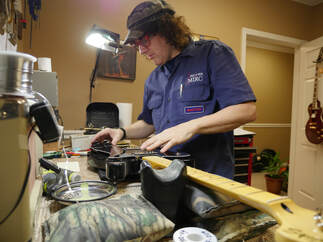 MIRC takes imperfect guitars and transforms them into quality instruments MIRC takes imperfect guitars and transforms them into quality instruments “I’m hearing lots of people say that they need something to take their minds off what’s happening, so they are focusing on guitar,” says Gano. “It’s my hope that we can help people turn this interest into a lifelong thing.” MIRC is a Franklin, Tennessee based company that takes “distressed” instruments from the industry’s leading guitar brands and rehabilitates them so they can be sold, or in GITC’s case, donated. Their small, dedicated staff is made up entirely of musicians who are passionate about their craft and pride themselves on being able to repair a broken headstock to where you can’t even tell it was broken.  These guitars are about to get a makeover! These guitars are about to get a makeover! “We are saving guitars from ending up in landfills,” Gano explains. In GITC’s case, MIRC was able to donate 5 Fender nylon string guitars that will go directly into the hands of teachers and students who need them, along with two beautiful Washburn cutaways and 11 Cordoba ukuleles. “I wouldn’t be where I am today without classroom guitar so I do what I can to give back,” says Gano. Of course, it doesn’t hurt that his wife, Rosemary, has been a guitar and piano instructor at West Potomac High School in Alexandria, VA for the last 20 years! We are so grateful to welcome the Ganos and MIRC into our GITC family! For more information on Musical Instrument Reclamation Corporation (MIRC), please visit their website www.mircweb.com.
Blog contributed by GITC Executive Director, Jess Baron San Diego, CA July 27, 2020 It's the end of July now, but back in late January, 2020, I began meeting meeting with the leadership of SAGE Magnet, a first-of-its-kind middle school named for promoting Sexual and Gender Equity that resides inside the larger Millikan Middle School in Sherman Oaks, California. We were meeting to explore designing a teaching artist residency to teach 6th grade students about social justice through making music. SAGE's mission is to provide opportunities for all students to become self-motivated, life-long learners in a safe environment where students are encouraged to become self-reliant and disciplined citizens. The school promotes academic and character development and fosters individuality, creativity, and teamwork. Mr. Joseph Porter, the SAGE Magnet Coordinator, had an inspirational vision to teach SAGE students how social change can be brought about in different ways. In alignment with the mission of the school, he wanted students to understand how working towards social justice can go beyond attending rallies and protests in the streets, chanting and carrying signs. He wanted to teach these sixth graders to discover the power of music to move hearts and minds toward justice. When we met, introduced by Shana Habel in the L.A.U.S.D. Arts Branch, there was no turning back. GITC has been sharing music from the Civil Rights Movement with teachers for 20 years. It couldn't have been a more natural setting in which we could bring music to learning. We began planning these music integration classes for the students at SAGE 7 weeks before the Coronavirus began turning life as we knew it into a fond memory. The plan was to teach voice, ukulele, songwriting and group music in service of encouraging students to use their own voices to become agents for social change. Little did we know we'd need to overcome technical hurdles galore to make it happen. But everyone hung in there- parents, teachers and students- and with leadership from Mr. Porter, we figured out how to create inclusive, authentic, student-centered instruction, even though we were all separated and could only see each other inside of little rectangular boxes. The project had been set to take place in person at the school, but when schools closed and teachers and students went home to shelter in place, we immediately pivoted the project to conduct the classes online over ZOOM. GITC sent instruments for students to Los Angeles and participating families picked them up safely from the porch of the SAGE parents foundation's president. The design of the project included 10 weekly group music lessons revolving around learning about social action for civil rights that included music, and instruction in singing, playing and writing additional lyrics. This allowed sixth grade students to connect current advocacy for justice with the history of change. Classes started well before the tragic murder of George Floyd sparked international uprisings to protest police brutality against Black Americans, bringing #blacklivesmatter to the forefront of public conversation and into the heart of vibrant, widespread social action. When people began taking to the streets, SAGE students were already studying the power of music to change hearts, minds and policies when they began seeing civil protest in action on their screens. The project became more real and important to students as they began coping with the complexity and seriousnes of the situation. "This Little Light of Mine" was chosen as a focus song for the class because it is simple, powerful and positive and is recognized as one of our nation's most jubilant and effective civil rights anthems. Today, demonstrators still leverage its message to push back against injustice. Mr. Porter's guidance and direction to students to study the history of the song and its role in civil protest was critical to the success of the project. In fact, highlighted in the SAGE video is footage of Reverend Osagyefo Sekou who used "This Little Light of Mine" to curb passions during a counter-protest, before a crowd of white supremacists and alt-right supporters gathered for the Unite the Right rally in Charlottesville, Virginia. The students speak to this use of song to combat violence with compassion and unity. Mr. Porter explains the heart of this collaboration. “For this specific project, I wanted to teach SAGE students how songs and singing have been used as successful tools for voicing specific needs for change throughout the history of social justice,” he says. “I feel it is important for them to know about the history of the traditional protest songs- who wrote, led and sang them, and when, where, and how they have been most effective in promoting non-violent movements for justice. To top it all off, I wanted the students to actually learn how to play and sing those same songs.” In addition to teaching the traditional lyrics, as the music teacher with the beginning students, GITC's hallmark student songwriting was woven into the class. Students composed their own verses of resilience to “This Little Light of Mine.” This allowed students to use the song to reflect on where resilience in their lives comes from. Students identified the positive activities they could engage in to uplift and encourage themselves despite the risks and losses caused by the spread of the Coronavirus. Each created a personal line or verse to the song. Together the old and new lyrics provided SAGE students with a way to help themselves and others.  The project was made possible through a generous grant from the Rosenthal Family Foundation. Monica Rosenthal, an enthusiastic supporter of SAGE got directly involved with the project, attending class with Mr. Porter and the students. Her presence added extra enthusiasm and energy to the music making. Thanks to their own determination and a supportive learning environment, SAGE students found learning about social justice through making music to be an engaging experience. Their attendance online was excellent. The end result was a team process, involving the classroom participants, GITC staff and SAGE family members who supported the students to practice and to make their own videos and wonderful leadership. "This truly was the result of the village all joining hands to lift up its children,” Mr. Porter explains. ”Together, the adults worked to encourage and empower these dedicated students to shine their lights with intention and clarity into our world during a pivotal moment in history and these kids came through wiser, more musical and empowered. We share this project with great gratitude to Mr. Porter, Ms. Habel, LAUSD's Arts Education Branch, and to the Rosenthal Family Foundation and Ms. Monica who made all our lives brighter by joining the class. Now, one parting shot. Please enjoy this little backyard recording Mr. Porter, a new musician himself, made to contribute to the overall class piece. Each time I listen to Mr. Porter's voice, I wonder how on earth he has escaped stardom! 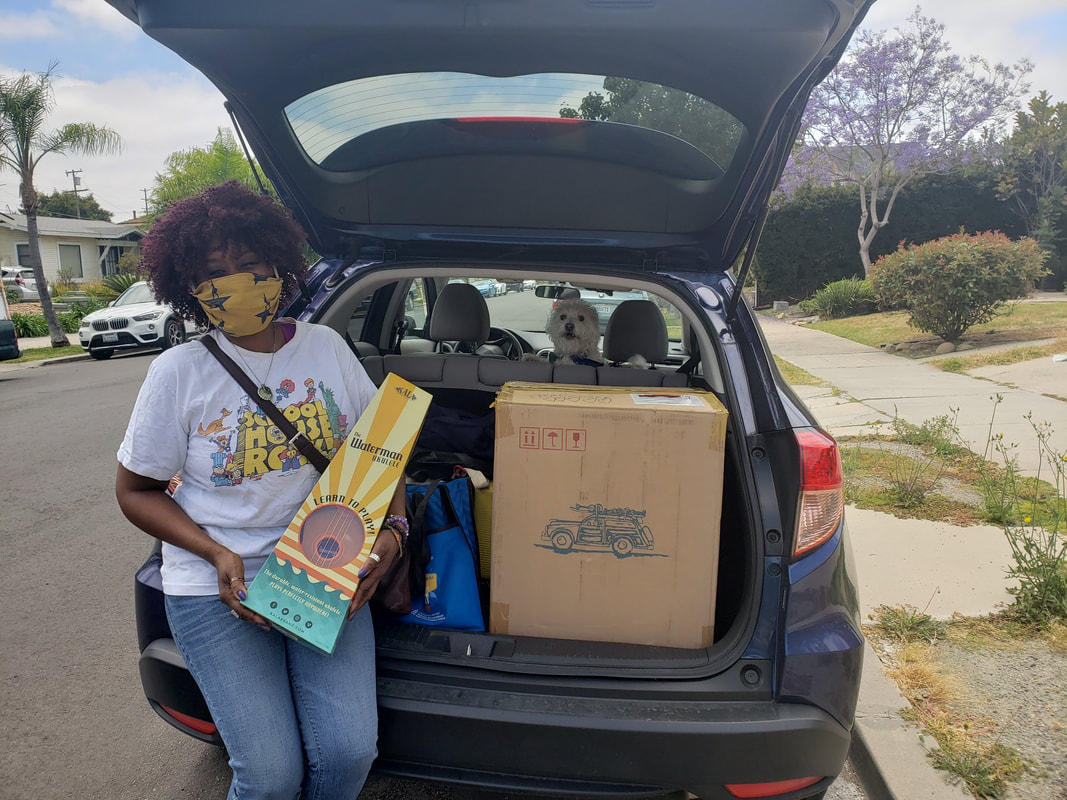 Some teachers go the extra mile -- literally. Francesca Miller is one of those teachers. When the pandemic hit and Ms. Miller’s kindergarten students transitioned to distance learning, she wasn’t ready to let go of the music they’d been making together in the classroom. Instead, she organized multiple Guitars and Ukes in the Classroom (GITC) socially-distanced Porch Pickups℠ so that her students could safely pick up free ukuleles to strum and sing along with their teacher from home. If families were unable to make the trip, she literally went the extra mile and dropped instruments off at their homes. Now her students, who are on a year-round academic calendar, play music daily as part of their distance learning curriculum. Ms. Miller reports that the ukuleles and interactive music making continue to have a profound impact. 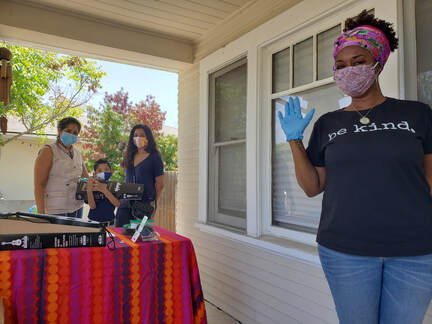 Ms. Miller (Right) greets a family at a GITC Porch Pickup℠ Ms. Miller (Right) greets a family at a GITC Porch Pickup℠ “Some students weren’t showing up to classes online at all, but the ukulele brought them back,” Ms. Miller explains. “It’s like that line from Field of Dreams...If you play it, they will come. Even if they are not turning in any assignments, they will come to class for the music.” Ms. Miller is no stranger to using music as a tool in the classroom. Even before she joined GITC in 2015, she started every class playing songs from a carefully crafted mixtape. But it was GITC that gave her the encouragement and the training she needed to do something she’d always dreamed of -- learn to play the guitar.  We KNOW these students are smiling under their masks! We KNOW these students are smiling under their masks! “I had my guitar but I wasn’t playing it. I like to say it had a really nice place hanging on my wall,” jokes Ms. Miller. “But then my principal at the time sent out an email about GITC, saying we could learn to play guitar and incorporate music in the classroom, and I said to my friend who was also a teacher, ‘Let’s do this!’ We took the class together and it was great because I really felt like I was on the verge of something.” Turns out she was on the verge of something greater than she’d imagined. With GITC’s support, Ms. Miller learned how to play ukulele and guitar; she also equipped her classroom with ukuleles to share at school and began strumming, singing, and writing songs for learning with her students. She saw positive effects almost immediately. “My favorite part was the songwriting,” she explains. “Something would happen at school and the kids would spontaneously say, ‘We should write a song about it!’ They were so excited and engaged.” Ms. Miller remembers one student in particular who was profoundly affected by the music. “I had a student in my class in Transitional Kindergarten (TK) and he had lots of absences. His mother didn’t want to send him to school if he didn’t want to go, so he rarely came,” she explains. TK students are 48-60 months old. 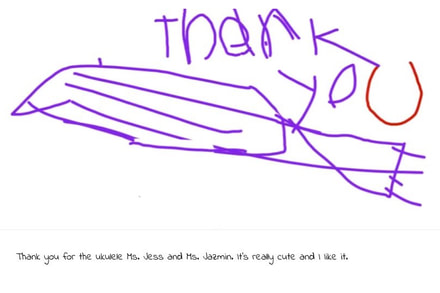 A thank you note from a grateful student A thank you note from a grateful student The following year she had him as a student again, this time in Kindergarten, and this time she was equipped with her GITC training and tools, including her own new ukulele! “Adding the ukulele changed everything,” she explains. “He would be the first one at the rug, ready and attentive. He was excited and alert. And when we first put that uke in his arms, he held it and looked like a master -- he had rhythm immediately!” He also attended school more regularly and became a more active participant in class. “I truly believe the ukulele contributed to him becoming more verbal in class. [Before the uke] he would talk with his hands in his mouth or spin and dance while speaking. After the uke, he learned to keep his hands by his side and to speak in a loud, clear voice,” says Ms. Miller. “Music is a language that everyone speaks and it reached him.” Music continues to reach Ms. Miller’s students as they explore the new realm of online learning. Although the class is currently strumming together online daily thanks to GITC board advisor, Jasmin Powell, who “adopted” the class and provided ukes for home, Ms. Miller hopes to devote one full day a week to the ukulele. She has of course encountered a few challenges -- Zoom delays, video that freezes, and students who can’t resist fiddling with the uke tuners -- but overall she views music as her greatest tool during this national crisis. “I can see it literally waking up their brains,” she explains. “I can see it shining out of their eyes, like laser beams!” Don't believe us? Check out the personalized thank you notes below! |
BlogArchives
June 2024
Categories
All
|
||||||||||||||
Copyright © 2024 Guitars In The Classroom. All rights reserved.
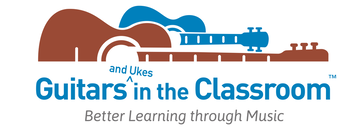
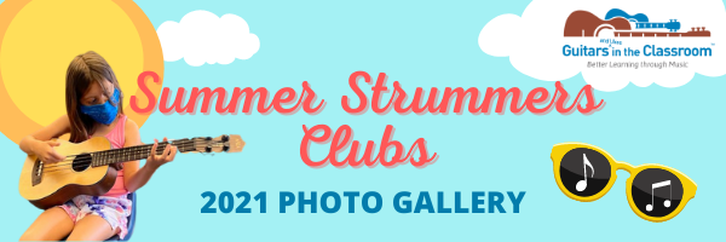


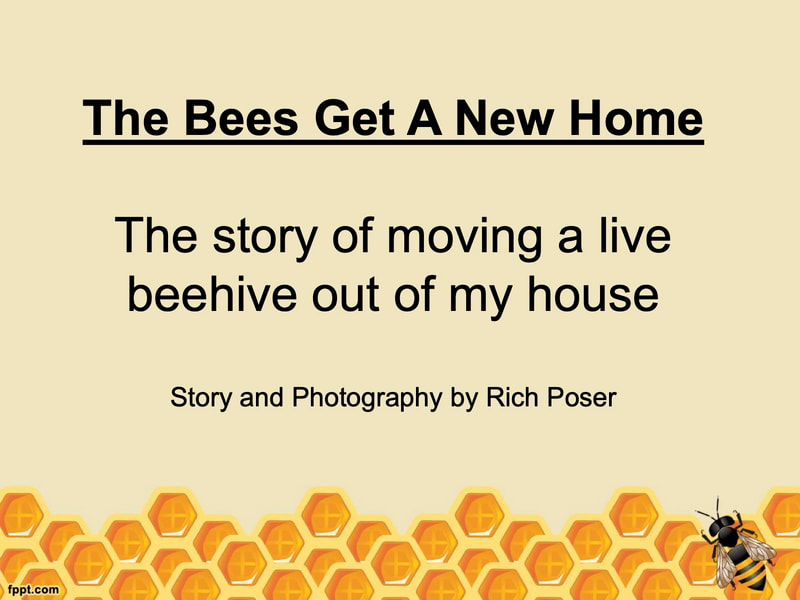
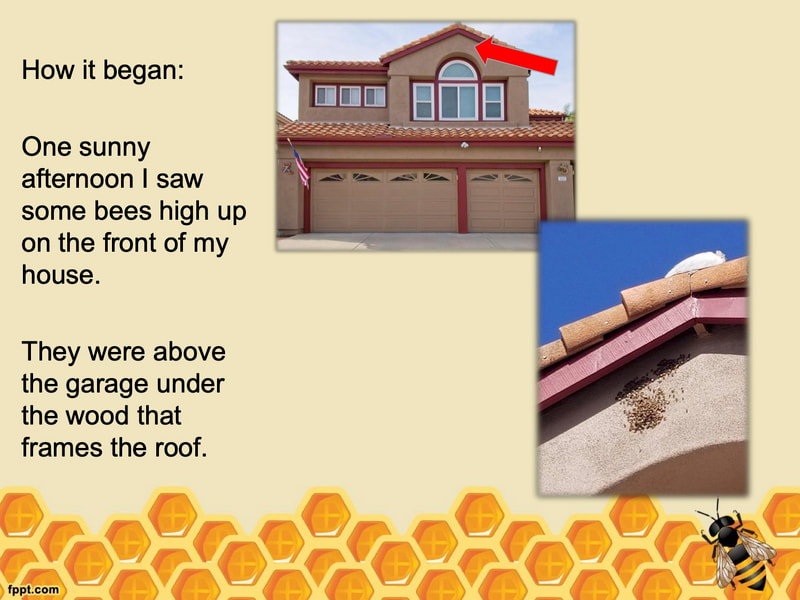

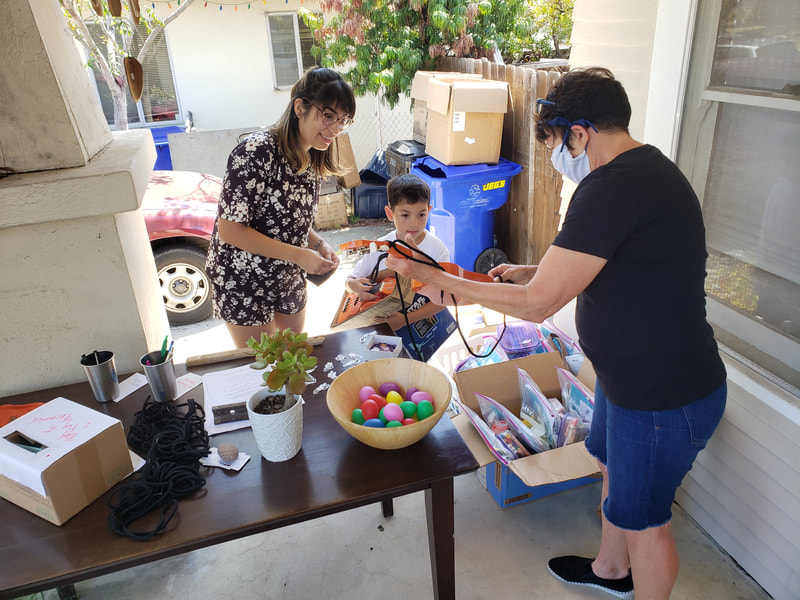
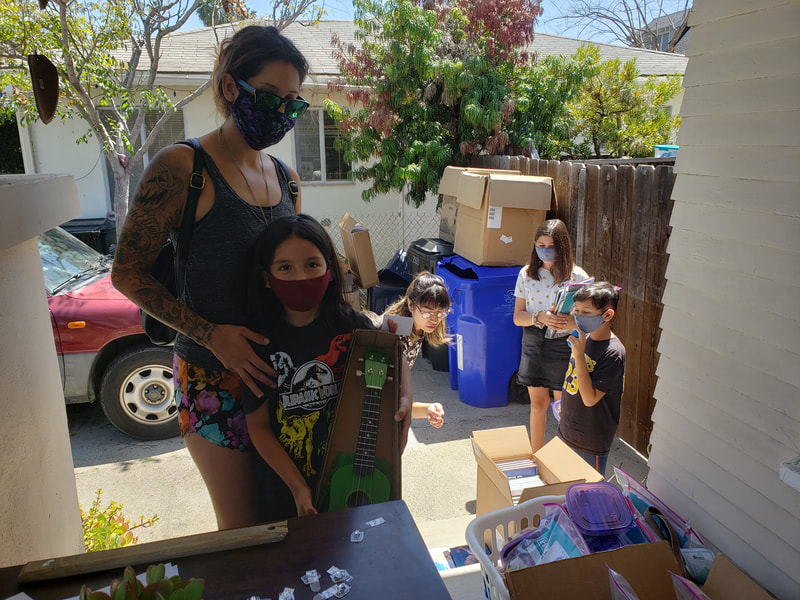
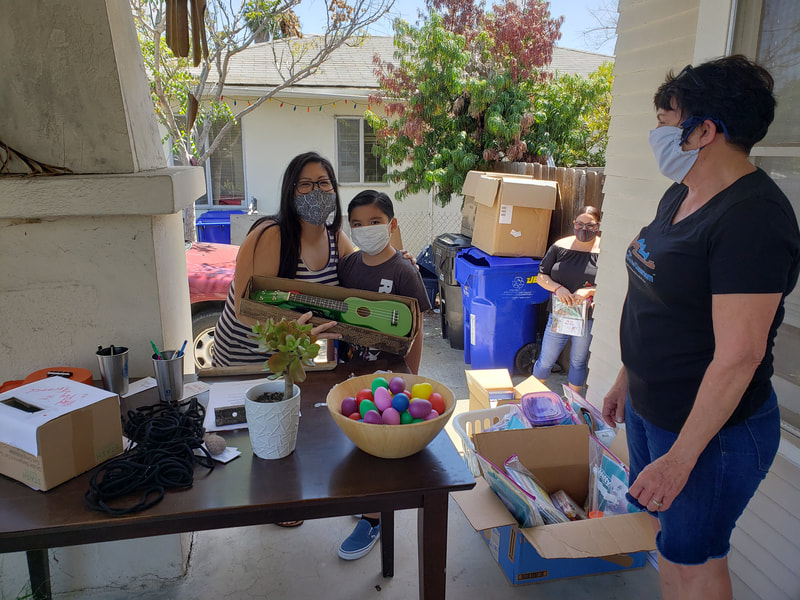
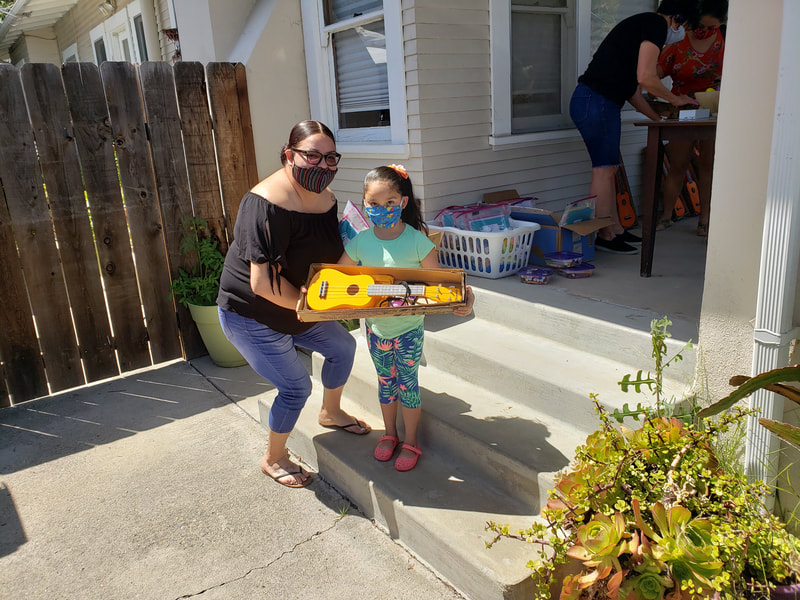
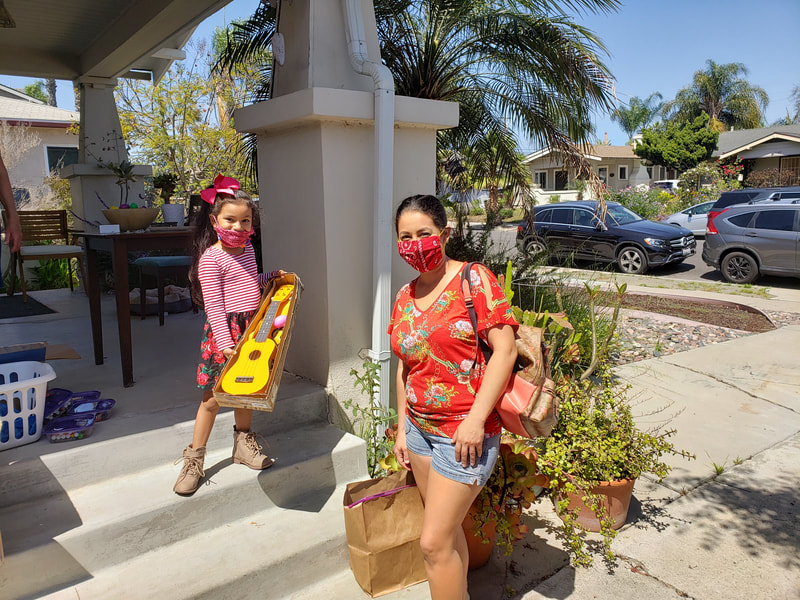

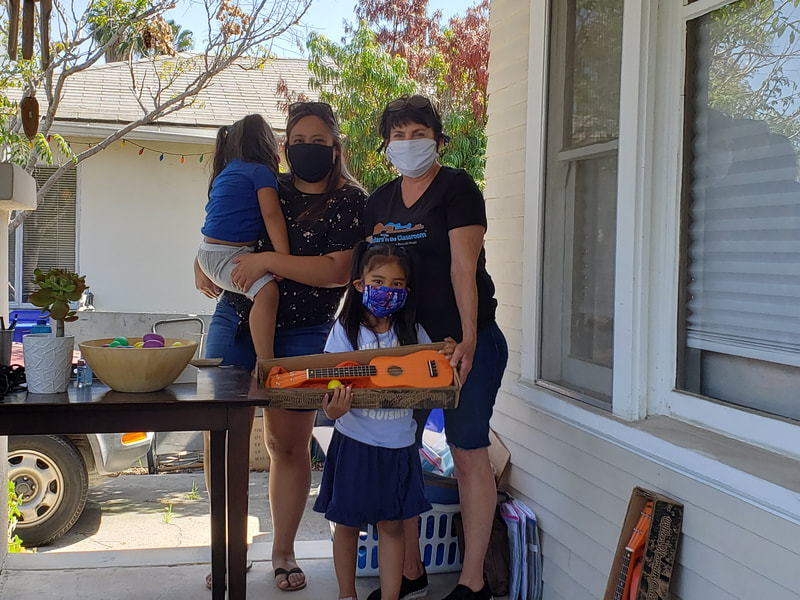
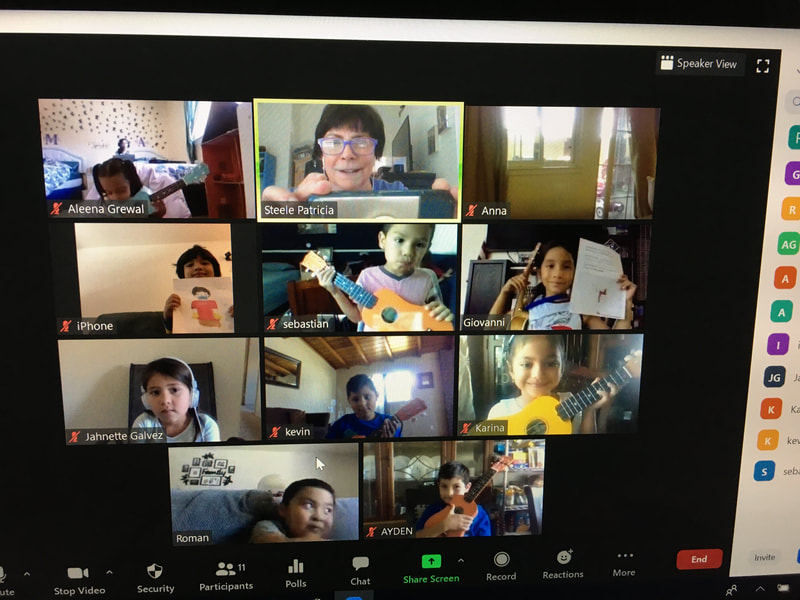
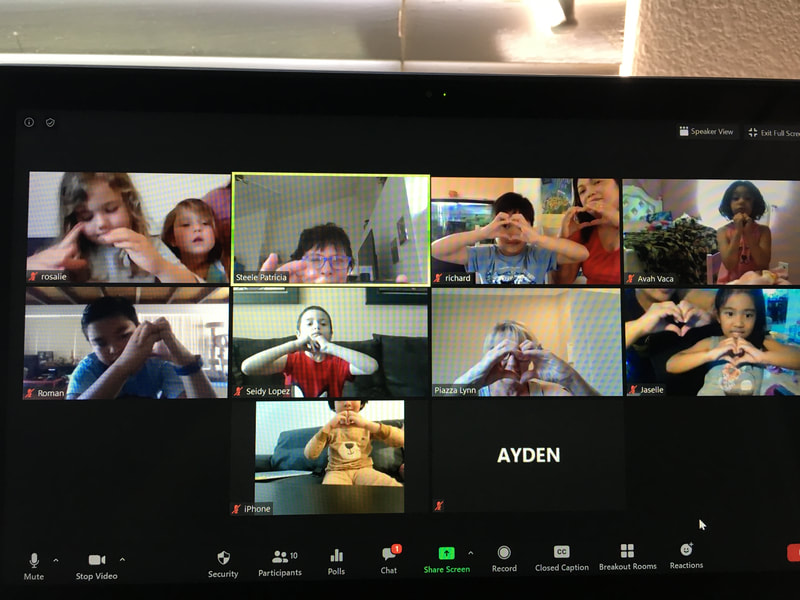
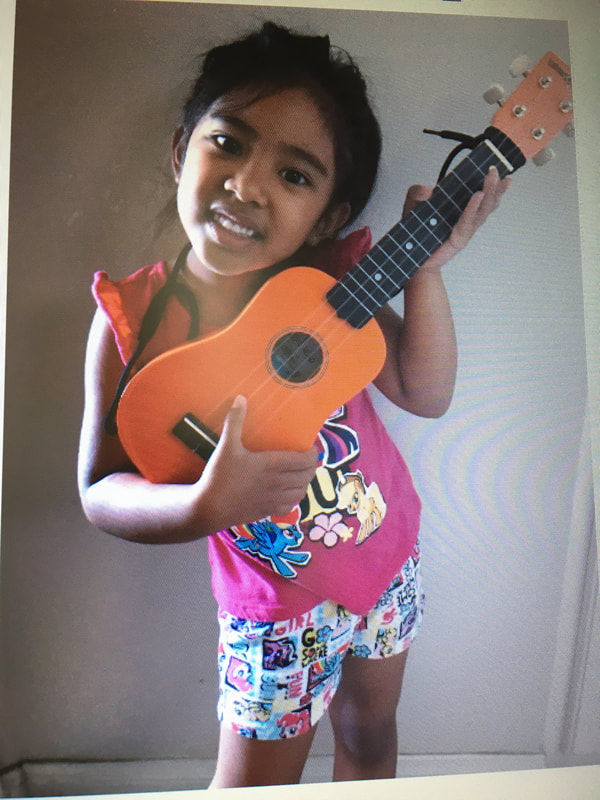
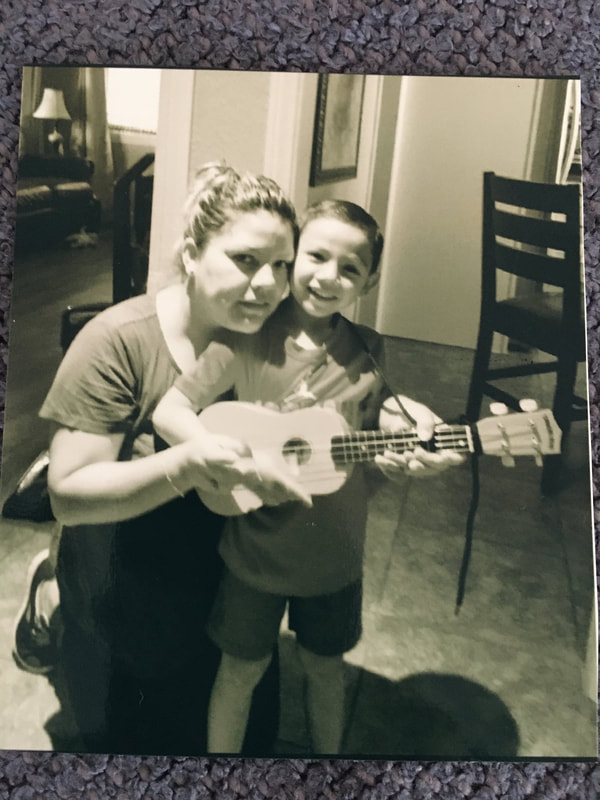
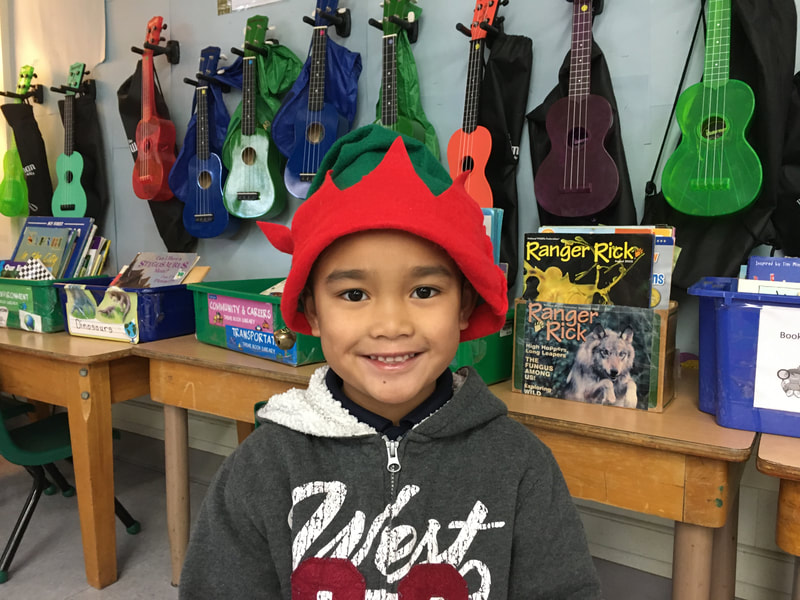
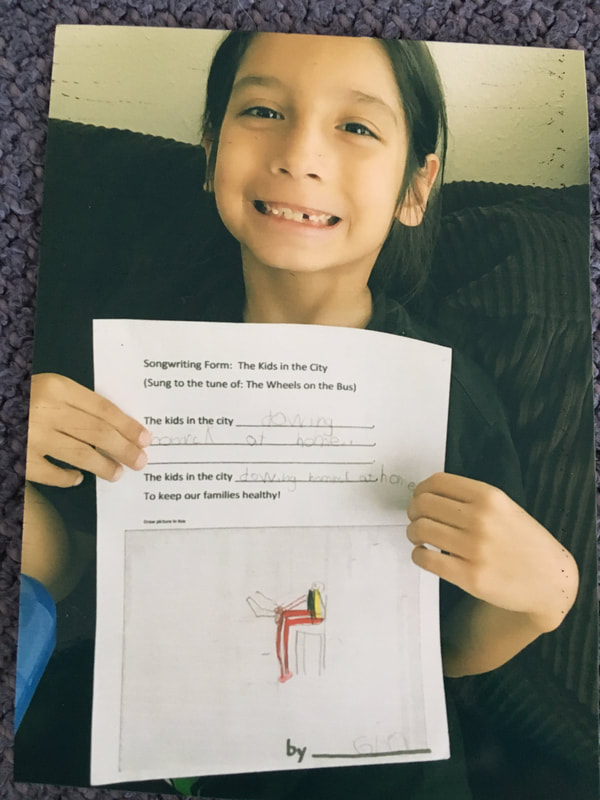
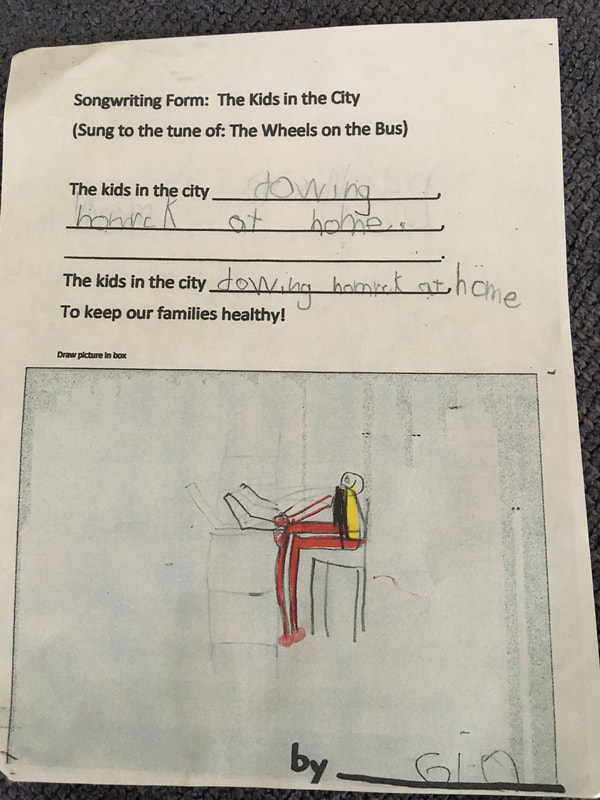
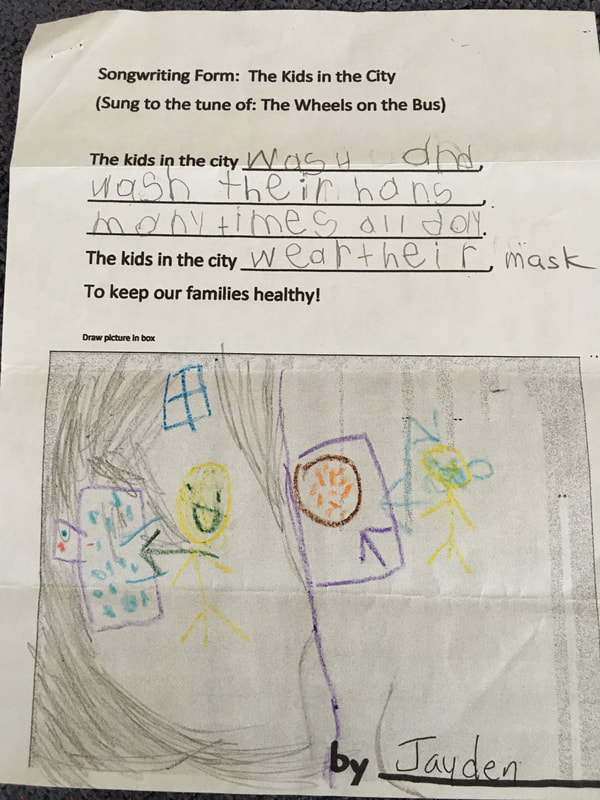
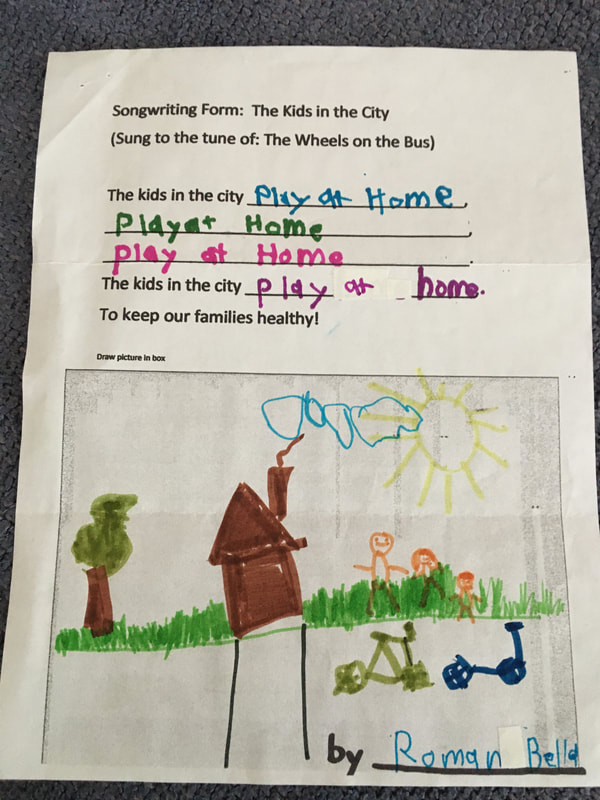
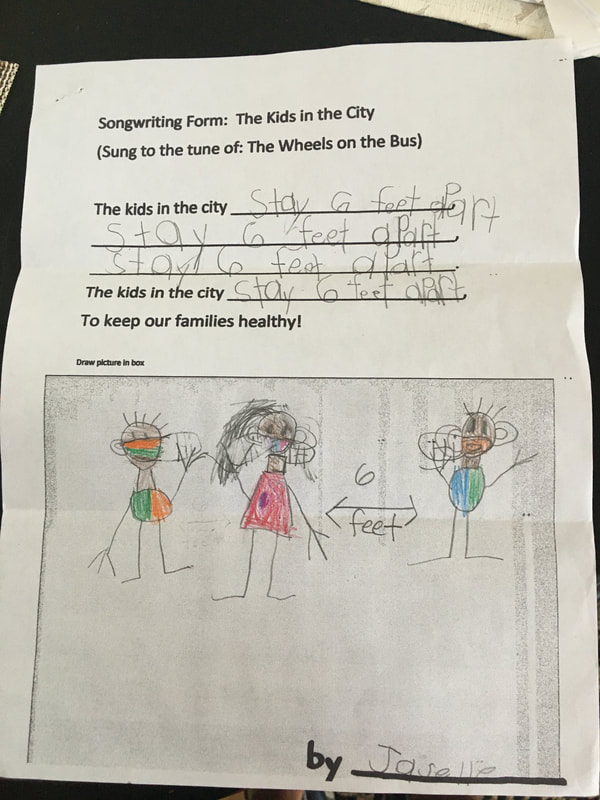
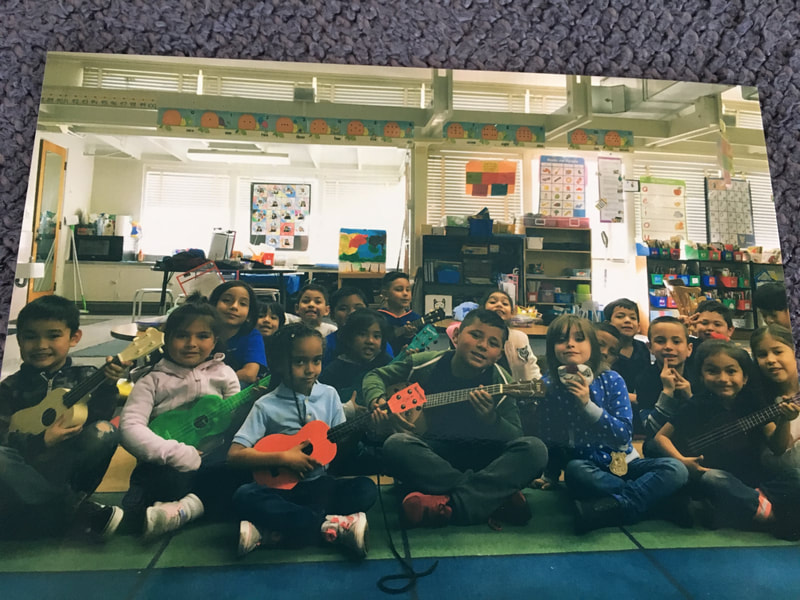
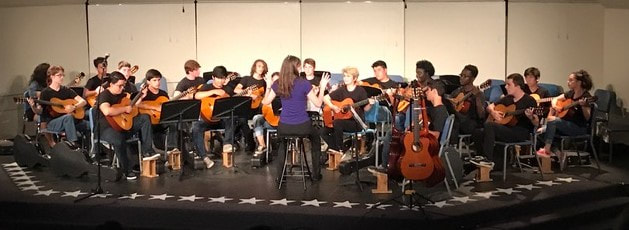

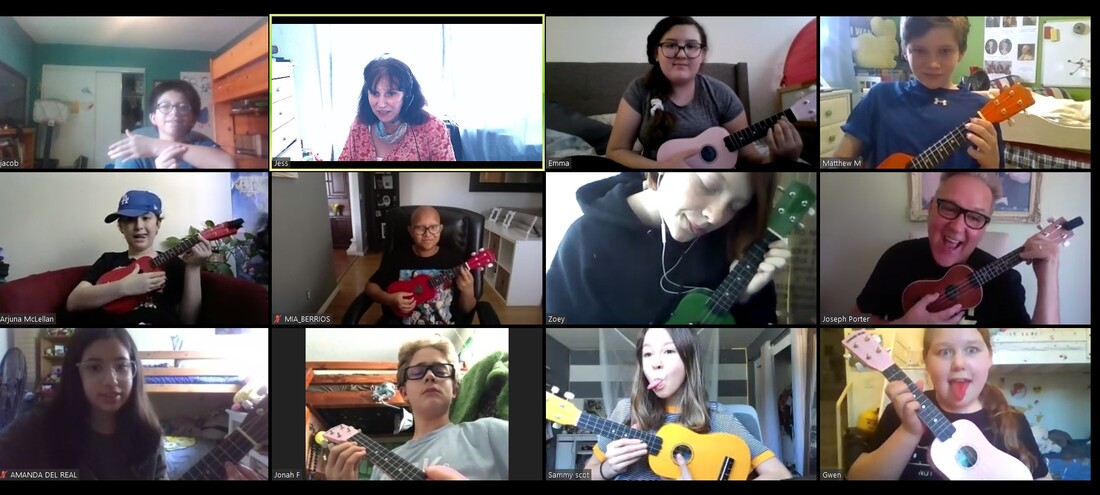
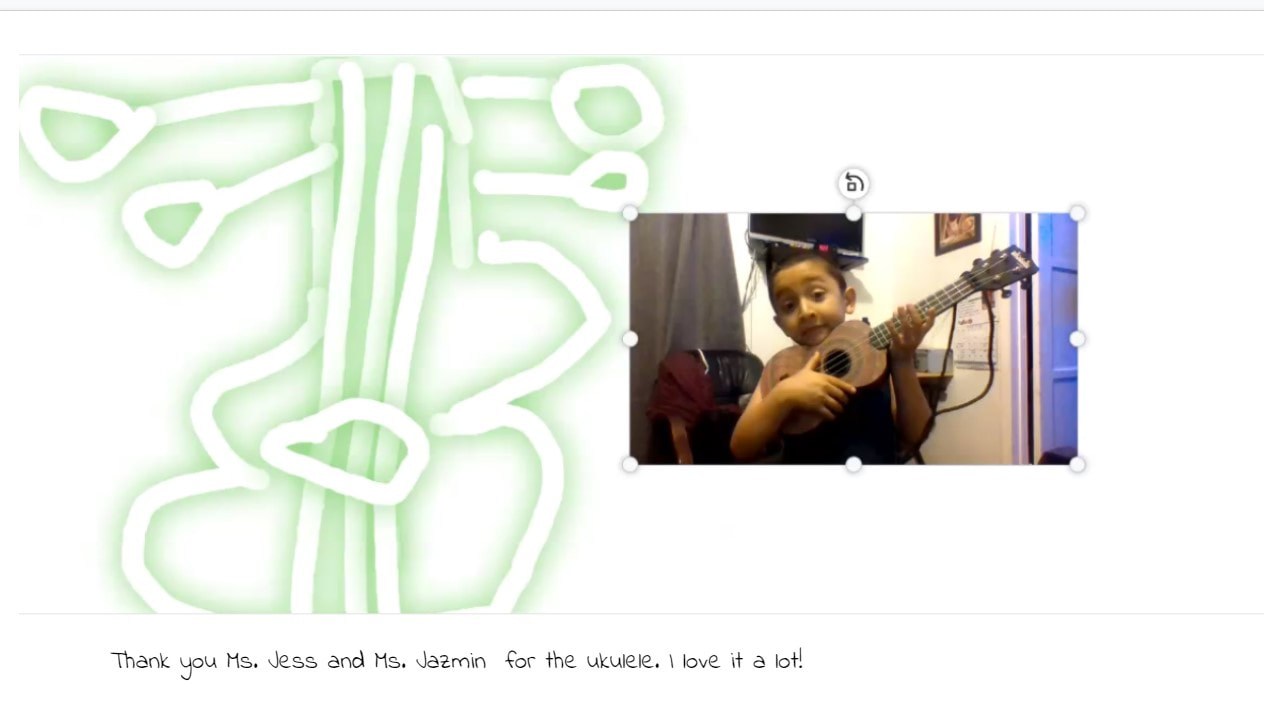
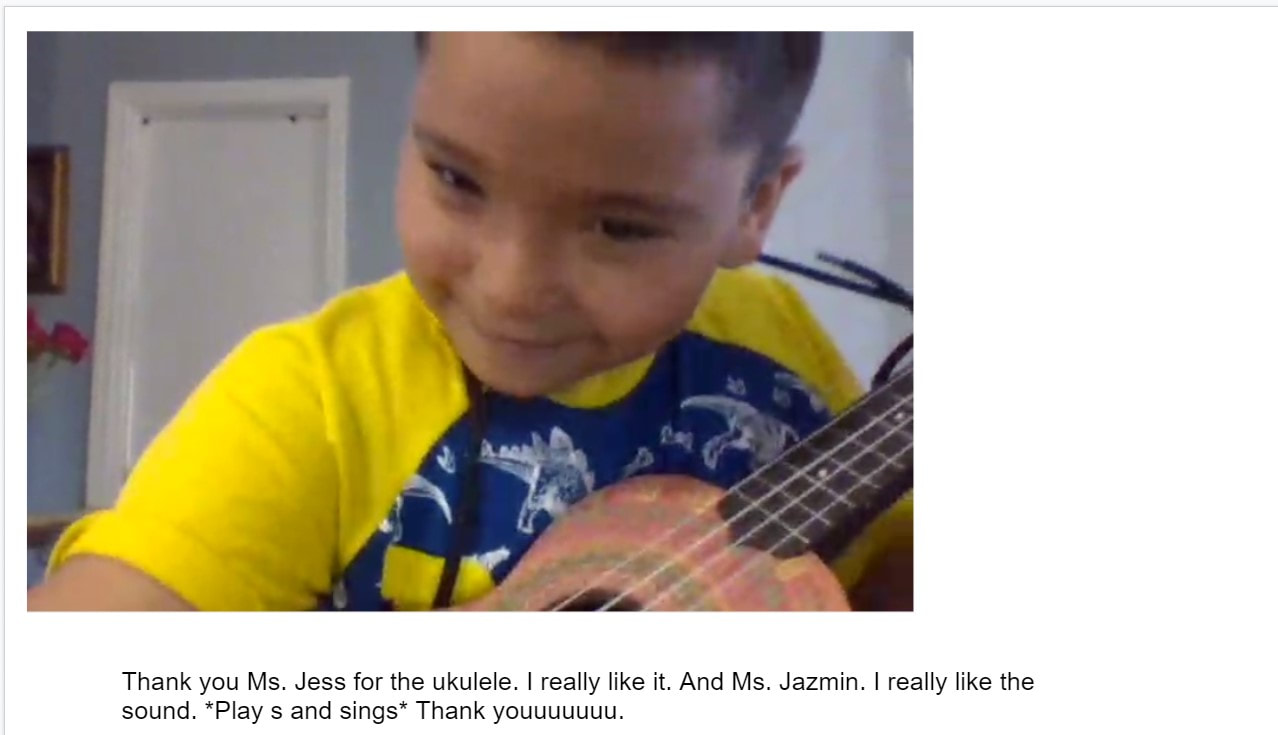
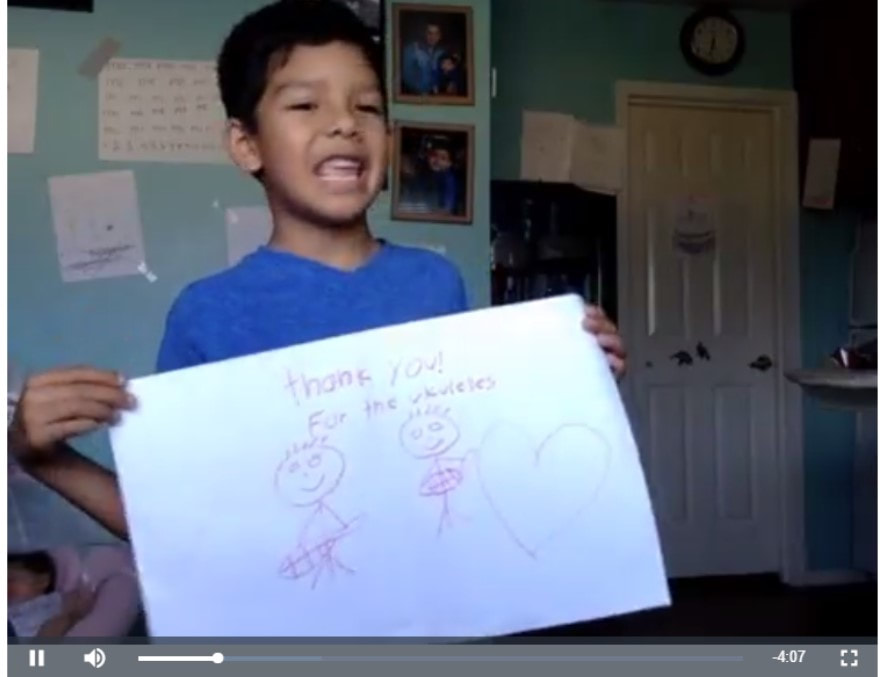
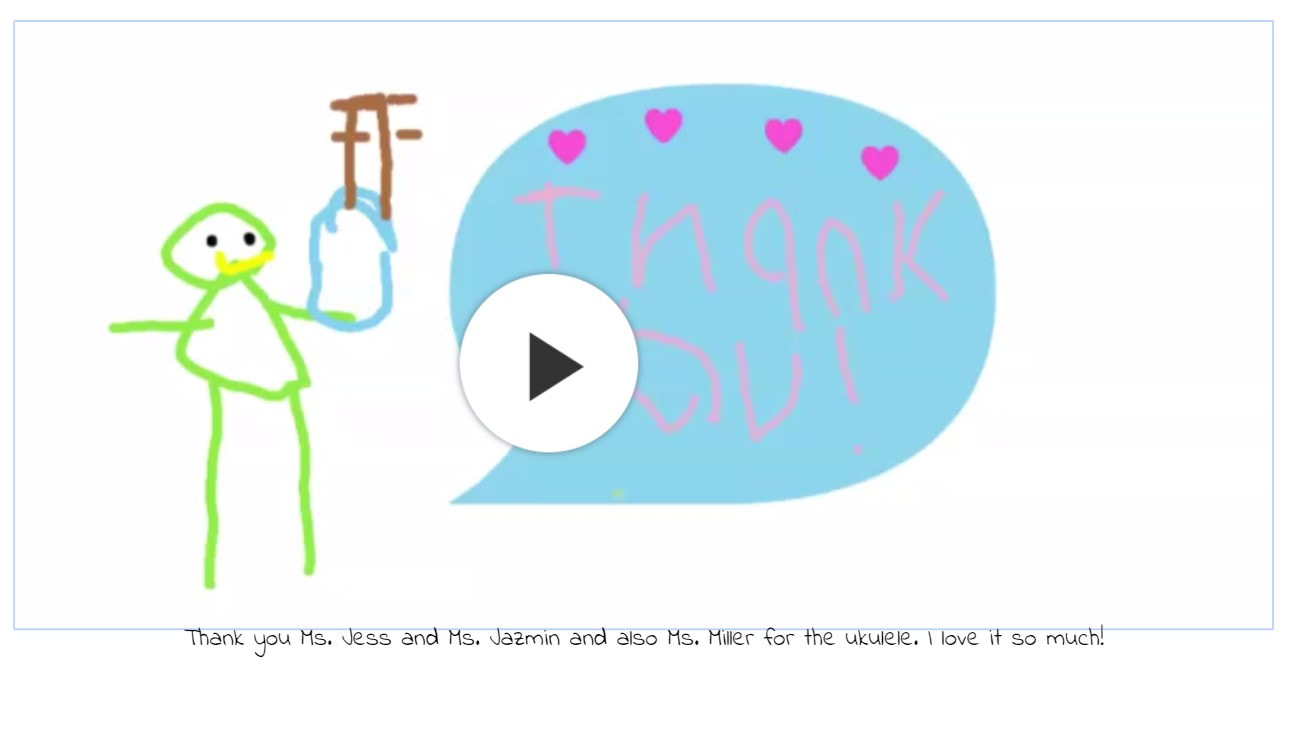
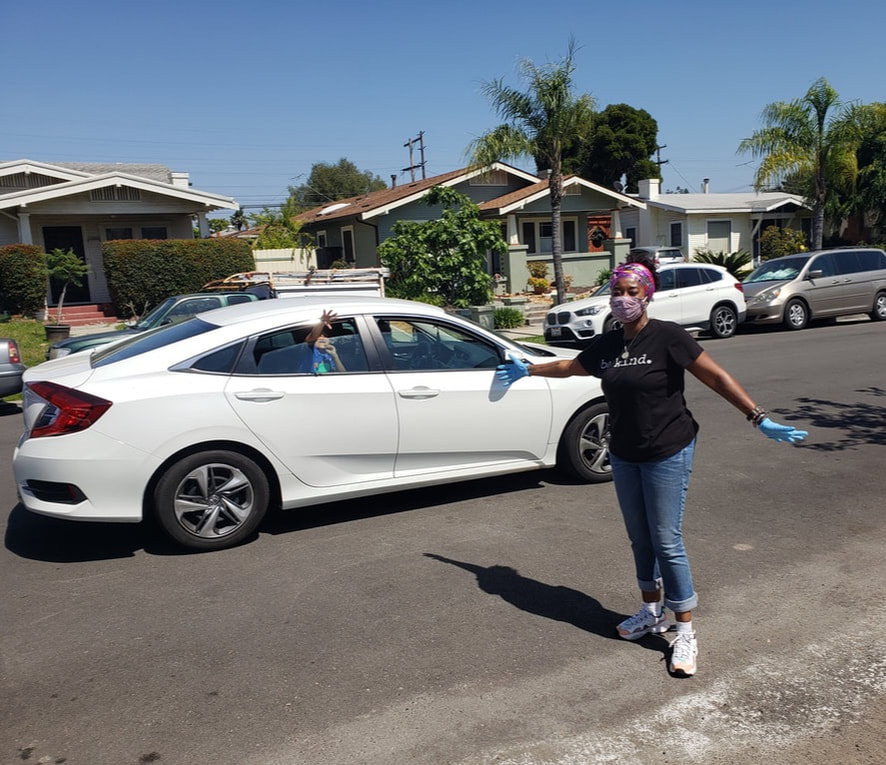
 RSS Feed
RSS Feed